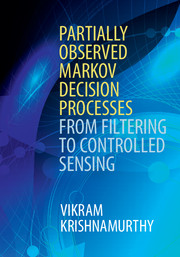Book contents
- Frontmatter
- Contents
- Preface
- 1 Introduction
- Part I Stochastic Models and Bayesian Filtering
- Part II Partially Observed Markov Decision Processes: Models and Applications
- Part III Partially Observed Markov Decision Processes: Structural Results
- Part IV Stochastic Approximation and Reinforcement Learning
- Appendix A Short primer on stochastic simulation
- Appendix B Continuous-time HMM filters
- Appendix C Markov processes
- Appendix D Some limit theorems
- References
- Index
Part III - Partially Observed Markov Decision Processes: Structural Results
Published online by Cambridge University Press: 05 April 2016
- Frontmatter
- Contents
- Preface
- 1 Introduction
- Part I Stochastic Models and Bayesian Filtering
- Part II Partially Observed Markov Decision Processes: Models and Applications
- Part III Partially Observed Markov Decision Processes: Structural Results
- Part IV Stochastic Approximation and Reinforcement Learning
- Appendix A Short primer on stochastic simulation
- Appendix B Continuous-time HMM filters
- Appendix C Markov processes
- Appendix D Some limit theorems
- References
- Index
Summary
Part III develops structural results for the optimal policy of a POMDP. That is, without brute-force computation, the aim is to characterize the structure of the solution of Bellman's dynamic programming equation by making assumptions on the POMDP model.
• Chapter 9 starts with the special case of fully observed finite state MDPs.
• Chapter 10 develops important structural results for the belief update using the HMM filter. These results form a crucial step in formulating the structural results for POMDPs. We will illustrate these results by developing reduced complexity filtering algorithms that provably lower and upper bound the true HMM filter posterior distribution.
• Once structural results are established for the HMM filter, the next step is to give conditions under which the value function, obtained as the solution of Bellman's equation, has a monotone structure in the belief state. This is the subject of Chapter 11. To illustrate this structural result, Chapter 11 gives two examples. The first example gives conditions under which the optimal policy of a two-state POMDP is monotone. The second example shows how POMDP multi-armed bandit problems can be solved efficiently.
• For stopping time POMDPs, Chapter 12 gives conditions under which the stopping set is convex and the optimal policy is monotone with respect to the monotone likelihood ratio stochastic order. Chapter 13 covers several examples of stopping time POMDPs such as quickest change detection and social learning that exhibit these structural results for their optimal policy.
• Finally, Chapter 14 gives conditions for general POMDPs so that the optimal policy is provably lower and upper bounded by myopic policies. In regions of the belief space where the upper and lower bounds overlap, they coincide with the optimal policy. It is shown that the volume of the belief space where these bounds overlap can be maximized via a linear programming problem.
- Type
- Chapter
- Information
- Partially Observed Markov Decision ProcessesFrom Filtering to Controlled Sensing, pp. 201 - 202Publisher: Cambridge University PressPrint publication year: 2016
- 1
- Cited by



